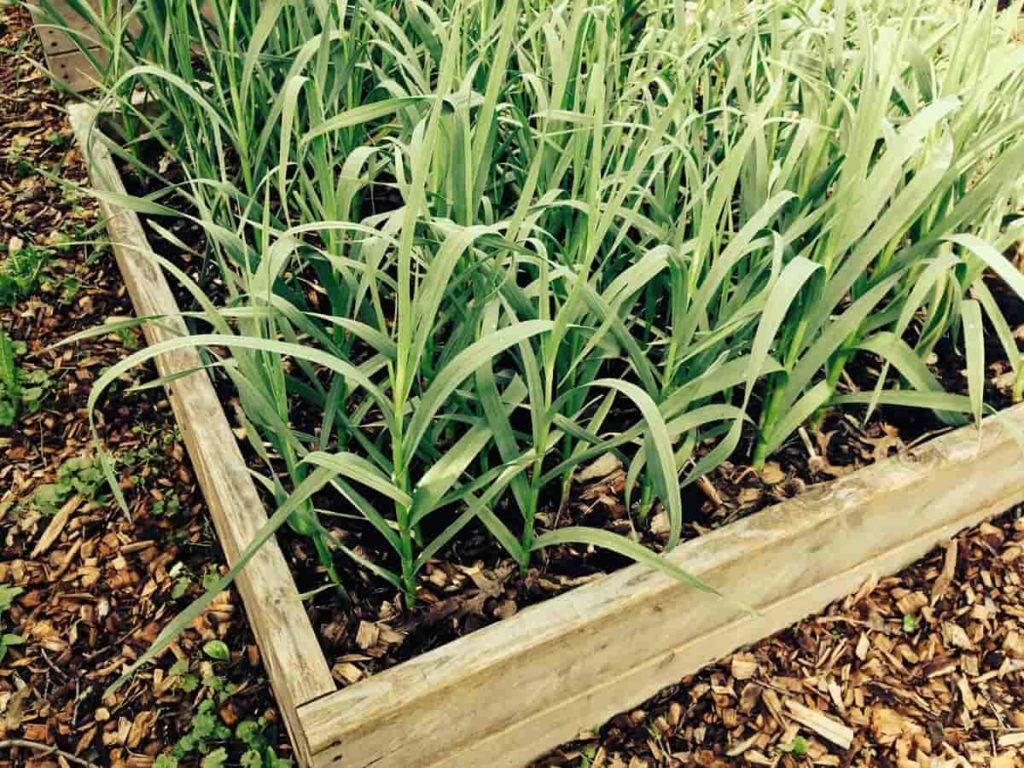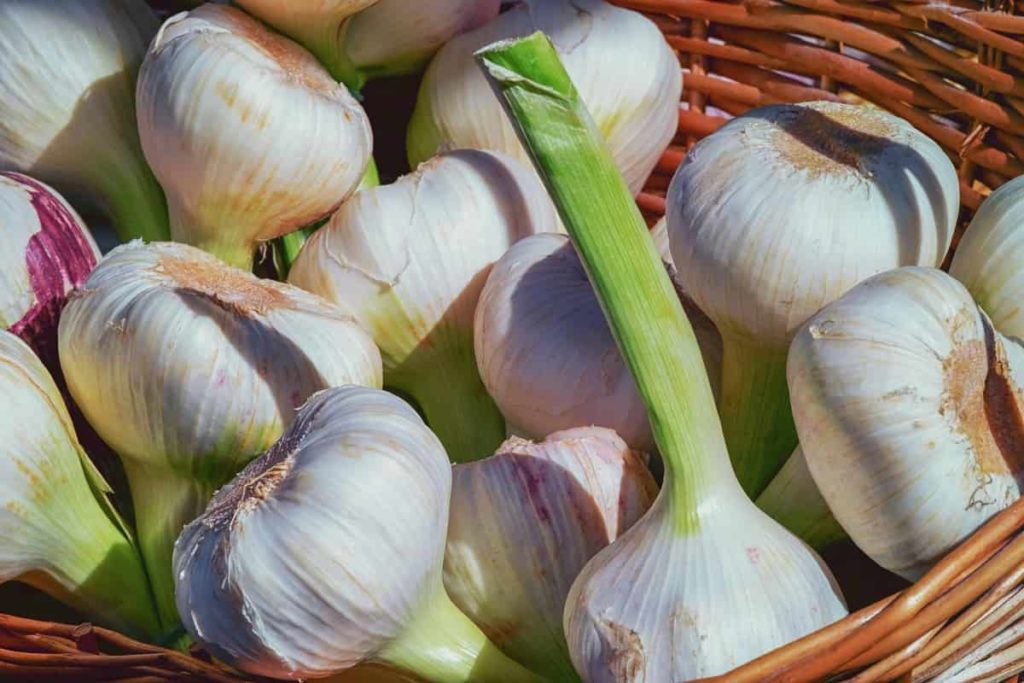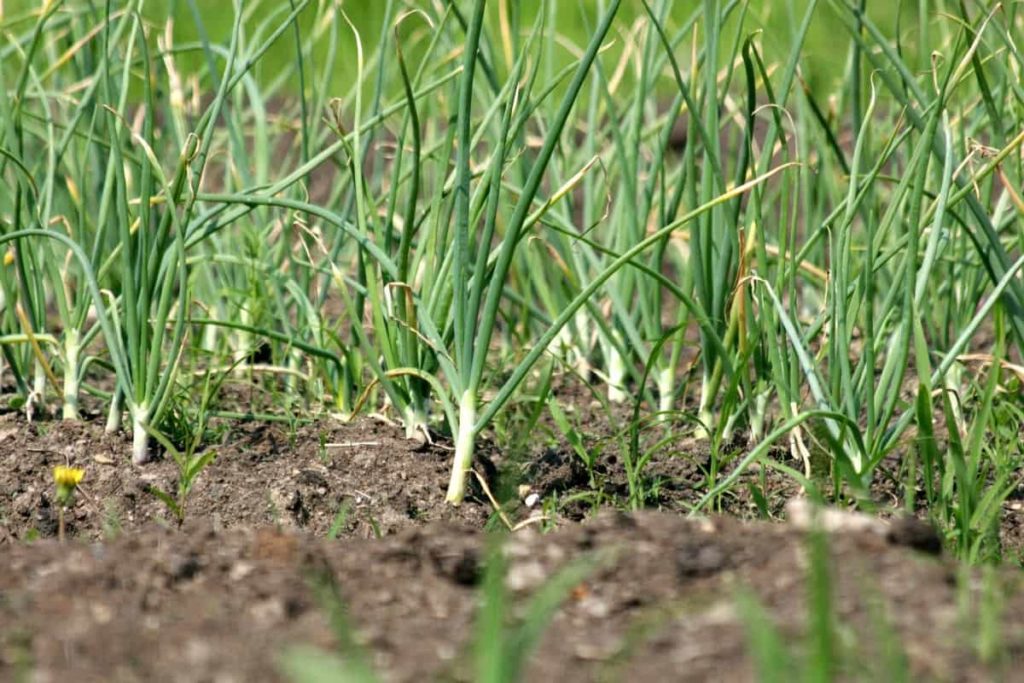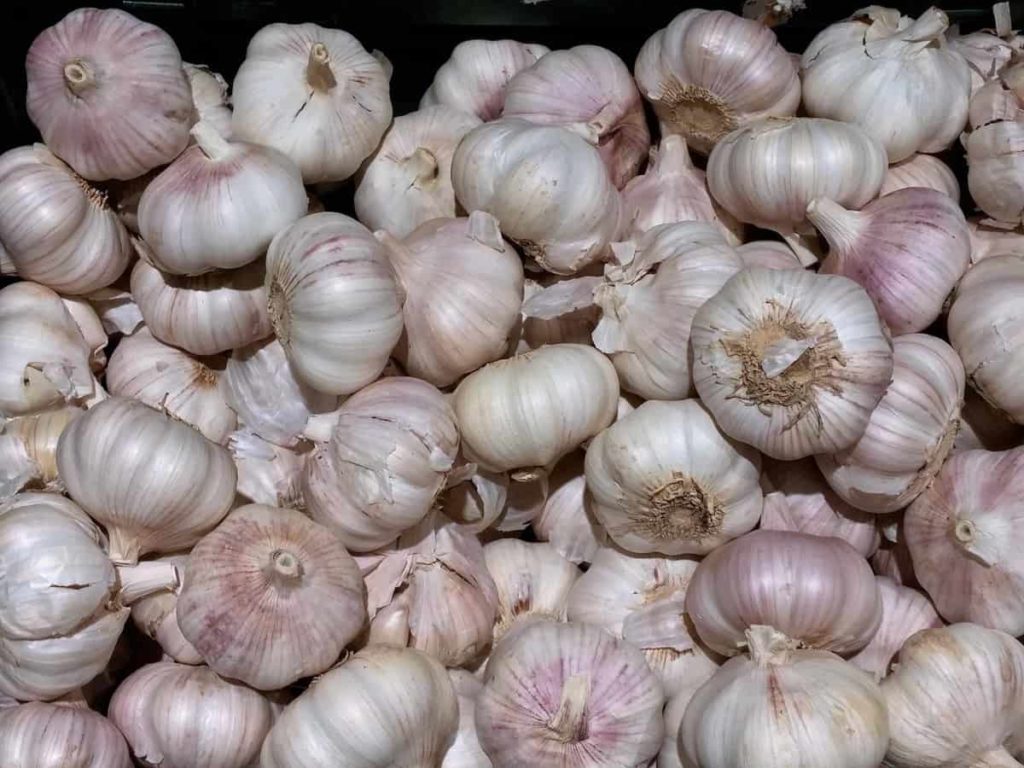Garlic is an easy-to-grow crop that needs not to be cared for, and if you set aside one or two heads from each crop to plant in the next season, you will never have to rebuy Garlic. Garlic is in the Allium genus, which includes Onions, Shallots, Leeks, scallions, chives, and ornamental Alliums.

As Garlic grows during winter, it is a great crop to keep your garden in production throughout the year. In addition, Garlic heads can last a long time when properly cured and stored, so they can be used in the kitchen and enjoy months more than many other vegetables from the garden.
Growing Garlic from seed to harvest
How long does it take for Garlic to grow from seed?
- It takes about 8 to 9 months for a small Garlic clove to be prepared to harvest Garlic.
- You can use the store-purchased Garlic bulbs to grow Garlic. Growing Garlic from the store is a very easy way to grow your fresh bulbs.
- Most varieties have about 90 days to harvest once growth begins. So if you’re looking for a taste of Garlic, elephant Garlic is not recommended.
What do you soak Garlic in before planting?
- You can soak your Garlic cloves in a solution of water, organic fish fertilizer, and baking soda is like giving your seed a kind of vaccine against various fungal diseases that can affect Garlic. Moreover, it gives them a good energy boost to start the growing process.
- Cover the cloves before planting in rubbing alcohol for 3 to 5 minutes, so the alcohol penetrates the clove cover and kills any mites inside. Then plant immediately or separate cloves and soak them in water for 15 to 30 minutes (optional addition as mites).
How much Garlic do you get from one seed?
- Every pound of hard neck seed Garlic contains 35 to 50 cloves. Each clove grows in its plant and Garlic bulb, and each pound will yield 35 to 50 Garlic bulbs (about 4-7 pounds).
- Soft neck Garlic seeds contain 50 to 70 cloves per pound, as the soft neck has more cloves per bulb than the hard neck.
- Garlic is easy to grow and requires very little space in the garden. Garlic grows from individual cloves broken from an entire bulb. Each clove will multiply in the ground, creating a new bulb that consists of 5 to 10 cloves or more.
In case you missed it: 16 Common Garlic Plant Problems: How to Fix Them, Solutions, and Treatment

What is the best month to plant Garlic?
- Garlic should be planted from late September to mid-October for best results.
- Garlic is often planted in the autumn (between September and late November) and harvested the following summer (between June and August). Plant Garlic cloves around 5 to 8 weeks before the first fall date, before the ground freezes.
- The longer the Garlic grows before the bulb, the larger the head will be. Planting Garlic in the spring takes less time for the Garlic to grow, so spring Garlic will be smaller than its more wintering counterparts and will not have classical cloves.
Does Garlic need full sun?
- When choosing a suitable place, remember that Garlic prefers a position with well-drained, light soil in full sunlight.
- Garlic requires a lot of sunlight to grow well. It can tolerate partial shade in very hot climates, as long as it is not during the day or for most of the growing season.
- Garlic works best in light, well-drained soil and loves full sun. Improve the soil by adding compost or well-decomposed animal manure before planting. It is important to regularly water and not allow the soil to dry completely during the formation of the bulb.
- Garlic will mature with the sun for 4 hours daily, but you can still harvest green Garlic with less sun. Related vegetables such as Onions, Leeks, and scallions can also be grown in partial shade vegetable gardens. Plant Garlic as soon as you work on the ground in the spring.
Does Garlic come back every year?
- However, since it is grown for bulbs, it is usually grown annually and re-planted yearly. If you want to grow Garlic as a perennial, you’ll need to leave the bulbs to prepare and grow for a few years, during which you can harvest milder-tasting leaves and flowers.
- Growing Garlic as perennial means less care, year-round harvesting, and never repurchasing seed Garlic. Garlic is very easy to grow as a perennial. Just plant Garlic as you normally do in the fall, and then ignore it for a few years.
In case you missed it: Homemade Fertilizers for Root Vegetables: Potatoes, Carrots, Beetroot, Onions, Radishes, Turnip, Ginger, and Garlic

How do I know when Garlic is ready to harvest?
- Most Garlic plants produce six to nine leaves. Each of these leaves extends under the stem and wraps around the bulb, forming part of the papery layers that cover and protect the cloves. The bulbs are ready for harvesting when the bottom two or three leaves turn yellow or brown.
- If you leave too long in the ground, over-mature bulbs can split, making them susceptible to molds and dehydration. Perhaps somewhere, the soil is loose and loamy enough to enable Garlic to pull out of the ground without tearing or breaking the stem.
Can Garlic be planted in pots?
- Growing Garlic in containers provides that just-picked taste for the strongest bulbs. In general, you should plant Garlic in containers only when you plant it in the fall on the ground, after the first frost when the soil cools down but before anything freezes. In most places, you can plant Garlic at any time from September to November.
- You need a drainage hole at the bottom of the selected container, and it is 8 inches deep space for the roots to grow. How wide the pot should depend on how many Garlic cloves you plan to succeed.
Does Garlic need fertilizer?
- Fertilize Garlic in early spring by side dressing or broadcasting it with blood meals, pelleted chicken manure, or synthetic nitrogen source. Then, lightly fertilize once again shortly before the bulb swells (usually in early May) in response to prolonging daylight.
- The best fertilizers for Garlic plants will be high in nitrogen, including blood meal or synthetic nitrogen sources. Work fertilizer one inch below the plant and about 3 to 4 inches for the side dress.
- The best fertilizer for Garlic bulb growth is one tablespoon of liquid seaweed and one tablespoon of fish emulsion combined with 1 gallon of water. You should not use nitrogen-heavy fertilizers on Garlic, as these will encourage much leaf growth and small bulb growth.
Does Garlic need a lot of water?
- Garlic doesn’t work well with the competition; it needs all the available nutrients. You should water every 3 to 5 days during bulbing. If May and June months are very dry, irrigate up to a depth of 2 feet every eight to ten days. Stop watering as it approaches mid-June.
- Too little water can put stress on plants, and too much water can cause bulbs to rot. If it rains less than half an inch weekly, fill the gap with supplementary water. It is better to water deeply but infrequently.
- The newly planted Garlic must be kept moist to help the roots grow. However, do not overdo water because Garlic does not grow well, or can even rot, if sodden during the cold months. If it does not rain, the water will deepen once a week.
- Simply stick the moisture meter in the soil, and leave it on for a day or two if it reads moist, and if it reads dry, give good water to it to ensure that the water reaches the roots. Other indicators of excess moisture may include bending, wilting greens, or falling over.
- Garlic requires one inch of water every week, either from the rain or water in hand, especially once the bulbs are formed. Water the Garlic when the soil feels an inch dry below the surface. Let the water soak for 6 to 8 inches to encourage the growth of deep roots.
In case you missed it: Soil Preparation for Garlic Plants: Best Soil Mix, pH, Compost, and Recipe

Why did my Garlic not form cloves?
- The common reason for Garlic bulbs not forming is inconsistent watering; if the soil is filled with water for a long time or remains dry for a long time, it will cause this result. Alternatively, the results may be similar if cloves were planted near the surface.
- The easiest solution to a problem with forming a bulb or clove is that your Garlic plants aren’t ready. Garlic takes at least 30 nights with temperatures below 10°C for good growth of cloves.
- It may not be ready if you pull a Garlic plant and see a small bulb or bulb with no cloves. You should leave the rest of the plants alone and give them some more time. It’s not until the last two weeks of ripening that you’ll be able to see the papery split between cloves.
What can you not plant with Garlic and onions?
- Garlic combines with most plants, but it should not be grown near Asparagus, Peas, Beans, Sage, Parsley, and Strawberries, as this will stop their growth. Garlic is antagonistic to some garden plants due to chemical or taste interactions.
- Onions are often prone to onion maggots, which can travel easily from plant to plant. Other plants such as Onions, such as Garlic, Leek, and shallots, are common targets of onion maggots. Avoid planting them near Onions so that onion maggots can’t travel easily. Planting onions and Garlic together will not drastically affect any crop. Still, it will greatly impact those around you as Garlic, Onions, Chives, and others in the Allium family repel many mites and grubs.
How deep should a raised bed be for Garlic?
- A raised bed would be an ideal place to grow Garlic. Raised beds should be at least 10 to 12 inches deep. And Garlic gets deep enough that freezing is not a problem if you follow the general rule of planting individual cloves six inches deep, which means four inches of soil on top of a two-inch-long clove. The depth of planting makes all the difference. Sow at least five inches deep if you’re not planning on mulching.
- Make sure and amend the soil with well-rotted manure or preferably with a standard fertilizer. You can spread 2 to 1 inch of compost throughout the plantation area and work it into the first few inches of soil. Garlic establishes its root system before sending a green shoot. Planted too early, the green shoot can grow several inches, and act as a straw in winter to draw water from the cloves, effectively desiccating and potentially killing them.
Is Epsom salt good for Garlic?
You can scatter a couple of tablespoons of Epsom salt on each square meter of the planting bed to increase the strength of your Garlic. This is because Garlic produces its flavor compounds using soil-sucking sulfur. Then the plants are too happy to get along with it, only need water occasionally during very dry periods, and offer you about eight times the amount put in until next June.
Are coffee grounds good for Garlic?
If you’re considering growing Garlic plants at home, keep in mind that they grow well in coffee grounds, whether added directly or through compost. A handful of leftover coffee grounds on top of the cloves will help them to grow, as Garlic likes the pH of acidic soil. But it should not be a concern if you are not growing Garlic near the footpath, foundation, or rocky area.
In case you missed it: How to Start Small Space Apartment Gardening from Scratch: Design, Ideas, and Tips

Can you plant a head of Garlic?
- Planting Garlic bulbs is very easy. Break down your Garlic bulbs into individual cloves, then apply each clove about an inch below the soil’s surface. Make sure that the pointy end of each clove is upwards.
- If you put a whole Garlic bulb instead of separating the head into its cloves and placing each one apart, the plants won’t have room to grow correctly. This is likely to result in very small Garlic plants that fail to mature in multiple cloves.
What soil does Garlic like?
Garlic needs rich, free-draining soil. On heavy soil, it can grow Garlic on the ridge of the soil. Ten centimeters deep, slightly less on heavy soil, plant bulbs in the full sun. They should be 18 centimeters apart in each direction or rows at a distance of 30 centimeters with 10 centimeters between cloves.
Garlic grows best in well-drained, moisture-free soil with a pH between 6.0 and 7.0. You can improve your soil’s organic matter content by adding well-rotted manure or compost in spring or autumn. You should not use fresh manure as it can contain harmful bacteria and increase weed problems.
What is the secret to growing Garlic?
Garlic grows well in planting sites with lots of organic matter. Garlic grows well in a warm, sunny place, in fertile, well-drained soil that is not too wet in winter. Generally, the garlic is planted in late autumn or early winter. You can sow Garlic directly in the ground or in small pots if you have heavy soil.
In case you missed it: How to Grow Spices in Pots at Home: Garlic, Ginger, Fenugreek, Turmeric, Clove, Cumin, and Cardamom

Conclusion
It is not difficult to grow Garlic. Growing Garlic plants is almost ridiculously easy. A few essential requirements are easily met: nutrient soil, adequate moisture, and planting and harvesting at the right time. Garlic is used in many Indian dishes and provides amazing health benefits. Growing Garlic in pots is not difficult; with this, you will be able to get a supply of fresh green stalks, flowers, and even Garlic bulbs.
- How to Grow Hibiscus from Flower
- Plantation Ideas for Home Decoration: A Beginners Guide
- Flower Garden Designs and Layouts for Beginners
- Planting and Spacing Techniques in Papaya: A Beginner’s Guide
- Growing Gold: Essential Techniques for Planting Pineapples
- How to Make Kalanchoe Plant Bushy: Home Remedies and Solutions
- 11 Reasons Why Your Gardenia is Not Blooming: Home Remedies and Solutions
- Eco Elegance: The Guide to Designing a Drought-Tolerant Landscape
- Gardening on a Slope: Strategies for Hillside Landscaping
- Nourish and Flourish: Top Organic Mulches for Thriving House Plants
- Everything You Want to Know about Indian Mogra Flower: Discover Uses and Growing
- Green Thumb Success: Expert Tips for Cultivating Greenhouse Pumpkins All Year Round
- Maximize Growth & Flavor: The Ultimate Guide to Companion Planting in Herb Gardens
- How to Control Rhododendron Problems Naturally: Home Remedies and Organic Ways to Fix Them
- Natural Magic: The Remarkable Benefits of Cinnamon for Plants
- Best Steps to Revive Dying Tulip with Natural and Organic Treatment
- 10 Reasons Why Your Angel Trumpet is Not Blooming: Remedies and Treatment
- How to Fix Periwinkle Leaf and Flower-Related Problems: Natural Remedies and Solutions
- How to Fix Zinnias Leaf and Flower Problems: Discover Natural and Home Remedies
- Organic Steps to Induce Lemon Tree Flowers: A Comprehensive Guide
- Bloom Booster: Crafting the Perfect Homemade Bougainvillea Fertilizer
- Optimizing Growth: A Guide to Applying NPK Fertilizer for Potted Plants
- 10 Best Homemade Fertilizers for Rubber Plant: DIY Recipes and Application Method
- How to Boost Female Pumpkin Flowers: Effective Steps for More Flowers and High Yields
- Transform Your Indoor Garden: Top Benefits of Pink Salt for Houseplants
- 10 Best Homemade Fertilizers for Peacock Plants (Calathea): Easy DIY Guide
- Unlock Blooms: 9 Reasons Why Your Potted Chrysanthemum is Not Blooming
- 8 Reasons Why Your Potted Hibiscus is Not Blooming: Fix it with Simple Solutions
- Unlock Blooms: 9 Key Reasons Your Potted Frangipani Won’t Flower
- 10 Reasons Why Is My Ice Plant Not Blooming: Remedies and Treatment
- 10 Reasons Why My Potted Hydrangea Not Blooming: Treatment and Remedies
- 10 Reasons Why is My Wisteria Not Blooming: Remedies and Treatment
- 10 Reasons Why is My Goldfish Plant Not Blooming: Remedies and Treatment
- Maximize Your Space: Ultimate Guide to Balcony Gardening with Grow Bags
- 10 Reasons Why Your Iris is Not Blooming: Remedies and Treatment
- 10 Reasons Why Your Anthurium Plant is Not Blooming: Treatment and Remedies